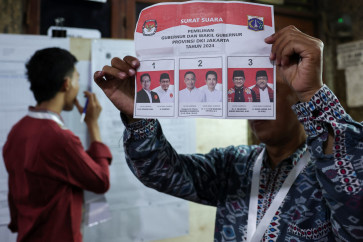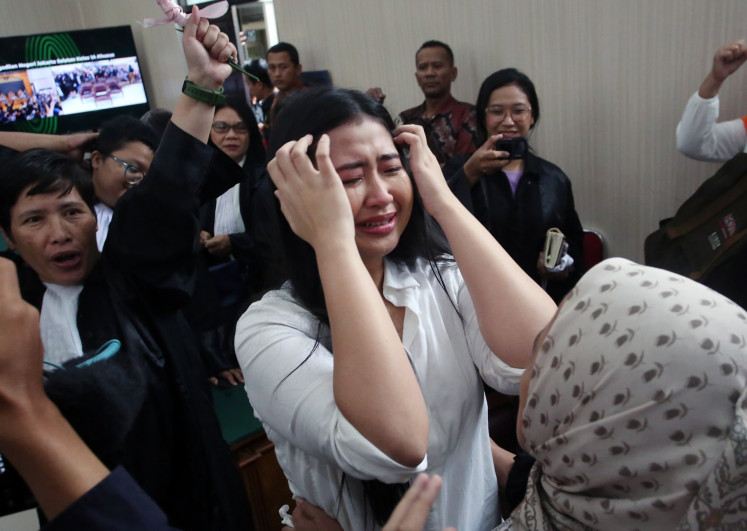Popular Reads
Top Results
Can't find what you're looking for?
View all search resultsPopular Reads
Top Results
Can't find what you're looking for?
View all search resultsThe Zamboanga standoff: Role of the Nur Misuari group
Early on Sept
Change text size
Gift Premium Articles
to Anyone
E
arly on Sept. 9, gunmen from the Moro National Liberation Front-Misuari Group (MNLF-MG) landed on the outskirts of Zamboanga city, Mindanao. The Philippine Navy engaged them in a firefight at sea, which then spread inland to coastal villages.
The next day, the Philippine media was awash with reports of villages occupied by armed followers of MNLF founder Nur Misuari. In the subsequent confrontations with Filipino armed forces, 107 have been killed, among them 71 MNLF-MG members and seven civilians.
The purported trigger for the Zamboanga Standoff was Misuari's perceived marginalization in the current peace negotiations between the Philippines and the Moro Islamic Liberation Front (MILF). The MILF broke away from the MNLF in 1978. The MNLF-MG is a newer breakaway wing of the mainstream MNLF ' a splinter group led by Misuari's right-hand man Ustadz Habier Malik, that continues its armed activities against Philippine government. Misuari's discontent boiled over on Aug. 12 when he reportedly declared independence for what he dubbed as a 'Bangsamoro Republik'.
Manila responded by reiterating the inclusiveness of the ongoing talks by conducting grassroots consultations in conflict-affected areas. A stronger response would have been problematic as Misuari explicitly called for a 'peaceful revolution' and not an outright call to arms. Misuari has seen his influence shift away from him even within the MNLF ' to another faction, the Central Mindanao-based Council of 15.
The MNLF-MG was formed in 2000 after Misuari was eased out from the MNLF core leadership by the Council of 15. While some see the splintering of the MNLF to be result of the government's divide-and-rule tactic, critics of the MNLF founder cite as a key cause his ineptitude as governor of the Autonomous Region of Muslim Mindanao (ARMM) that was created by the 1996 Philippines ' MNLF Final Peace Agreement.
In this light, Misuari's recurring power plays have been cast as moves to recapture power and status. The Zamboanga standoff is not without precedent. In November 2001, the MNLF-MG forcibly occupied the Cabatangan Complex, northwest of Zamboanga City. The failure of the 1996 Philippine-MNLF Final Peace Agreement to include adequate measures for disarmament, demobilization and reintegration (DDR) of MNLF fighters gave the Misuari faction the continued capacity for armed violence.
Lax enforcement of firearms laws in the Philippines tolerates the penchant of active and former MNLF members, even their relatives, to publicly brandish their weapons. When confronted by law enforcement officers, MNLF members would conceal their weapons and cry harassment, stressing the fact that the MNLF is a legal organization.
The ability of the MNLF-MG to posture itself as a legitimate organization is consistent with the level of non-violent activism permitted within the Philippine political system. Misuari's spokesperson decried what he alleged as the harassment of a planned 'peaceful rally' and that the armed men were just an 'advance party' to secure Nur Misuari's participation in a mass protest action in Zamboanga City. This obscures the real objective of the MNLF-MG.
These mixed messages reflect the MNLF-MG's astute appreciation of the Philippines' grey areas for political activism. Nor did the hundreds of armed MNLF-MG appear overnight. The Philippine military had monitored the movement of unarmed MNLF members in Zamboanga City three days before the incursion. Unarmed MNLF members based in Zamboanga subsequently joined the armed MNLF-MG members who landed.
The standoff can act as a catalyst to radicalize different factions in the Southern Philippines into violence. Death and injury to unarmed MNLF supporters can stoke latent resentment and discontent among unarmed sympathizers to the Muslim secessionist cause, whether from the mainstream MNLF or the MILF members who are engaged in talks with the government.
On the other side, casualties among the mostly Christian population of Zamboanga can be used by pro-government Christian militias to justify reprisal attacks not only against MNLF-influenced villages but also MILF communities in Central Mindanao. The narrative of violence and the images resulting from the standoff can be exploited by multiple parties and set back the Malaysia-brokered peace process currently underway.
The consequences of the standoff do not stop at the negotiating table. Nor should the standoff be dismissed as a domestic dispute as history has seen the conflict spill over the Philippine border. In the aftermath of the 2001 Cabatangan crisis, Misuari fled to Sabah in neighboring East Malaysia and was subsequently captured by Malaysian security forces without resistance.
The potential for violence is even more pronounced today if Misuari's followers flee from the Zamboanga standoff into Malaysia again. Following the February 2013 Lahad Datu incident, which saw the incursion of Filipino Tausug gunmen claiming to be the 'royal army' of the defunct Sulu Sultanate, Malaysian security forces have heightened security. There are overlapping objectives between the politics of Misuari and the Sultan of Sulu, given that both are Tausug and can leverage on ethnic and clan network straddling the border.
This proverbial powder keg can be sparked off by any attempt by Misuari or his followers to seek refuge in Sabah and potentially triggering a reprisal of Ops Daulat by Malaysian security forces earlier this year in Lahad Datu. Clearly, the dynamic situation on the ground can create spillover effects. Any protracted standoff would only worsen the potential adverse consequences to the Philippines and beyond.
The writer is an associate research fellow at the Center of Excellence for National Security (CENS), a constituent unit of the S. Rajaratnam School of International Studies (RSIS), Nanyang Technological University.










